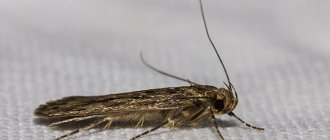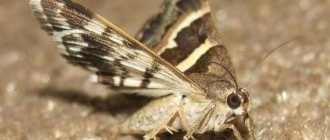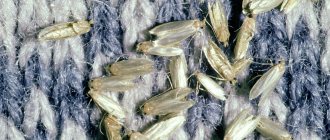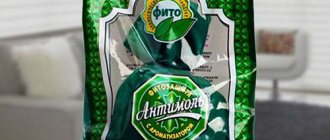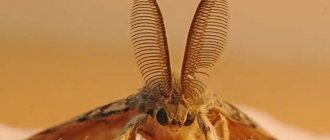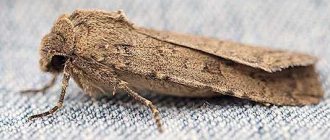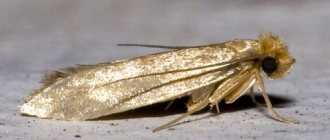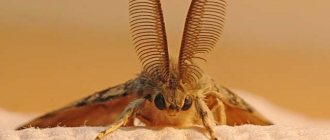When we say that “moths have spoiled all things,” meaning both clothes and food, we are not entirely right. It is not the adult that spoils all this, but only the moth larvae, since moth butterflies do not have a proboscis with which they could do this. The adult lives from the reserves that the larva has managed to make. And in order to “last” longer in its adult state, the caterpillar eats everything around that corresponds to its ideas about nutritious nutrition.
Every housewife knows that it is not only clothes that suffer from the pest. But not everyone understands that hundreds of species of this insect can live in a house, each of which eats one type of food. Moth larvae, depending on the species, eat fabrics, furs, feathers, bread, flour, nuts, cereals, dry fruits, pet food, etc.
Only a professional can distinguish moth larvae of different species by sight, since they are all very similar to each other.
Benefits of pests
Wax Moth
It is interesting that the moth larva can be beneficial. Thus, to treat tuberculosis, a beehive pest, the wax moth, is used. Caterpillars of this species are used as a base for wax moth tinctures and extracts. The enzymes used by the insect to break down the wax act in a similar way on the tuberculosis bacillus. Once exposed to the enzyme, the disease responds more quickly to antibiotic treatment.
Other species, such as burdock moth larvae, are used as bait for ice fishing and other types of fishing.
What does an ermine moth look like (photo)
Judging by the title, readers probably immediately associate it with a parasite on the furry animal ermine. However, this is not at all true. To know this, you need to know your enemy by sight.
This is what a harmless moth looks like.
And these are her larvae.
This happens if you don’t start fighting the pest in time.
During the period of mass reproduction, caterpillars form large cobweb nests on trees; at an accelerated pace, they literally leave trees without foliage in a week, enveloping them in a cobweb shroud.
Scientists associate the rapid reproduction of ermine moths with increased solar activity, which is observed every 11-12 years. However, during increased solar activity, plant biomass increases, that is, the food supply for pests increases. So they reproduce in greater numbers.
However, thanks to its greater resilience, bird cherry is the first to take the blow. Completely destroyed foliage on trees after pupation of the caterpillars grows foliage again after a month. But even if you cut down the affected tree, you will not get rid of the pest, because all the larvae have gone into the ground. And next year they will attack your trees again with new, and perhaps even greater, force.
Features of different types
In the home, moth larvae are usually divided into clothing moths and food moths. It is easy to understand that the first of them eat dry goods, and the second - groceries. The moth larvae in the photo and in person appear to be exactly the same, but there are differences between them.
food moth
It is not difficult to recognize food moth larvae: they are small worms, white or almost transparent. The head is clearly defined, 2 pairs of legs are located on the first segments of the body, 4 pairs are located on the abdomen. The length of these worms does not exceed 2 cm. The volume of the caterpillar directly depends on the type of food it prefers. If it is fatty food, the faces of the food moth will be thick. If the caterpillar has been on a “diet”, it will be very thin.
On a note!
Food moth caterpillars feed only on food. Damage to furniture or things is not her responsibility. Therefore, those housewives who saw larvae in flour can be calm about the contents of the cabinets. But preventive measures should be carried out regularly, since there is no guarantee that another type of moth that eats fur coats does not live in the house.
Food moths
Those products in which food moths are easily found:
- Flour;
- Cereals;
- Dried fruits;
- Nuts;
- Pasta;
- Seeds;
- Candies;
- Cookie.
Food-eating moths and their larvae prefer foods rich in carbohydrates. The jaws of moth caterpillars can gnaw through even the hard shells of grains. You can find out that a pest has settled in the closet by the following signs:
- Cobwebs in rump;
- Tunnels filled with waste products of larvae;
- Lumps in fine grains and flour;
- Leftover skins.
Interesting!
If you disturb the shell of the cocoon or the lumps of grains, you can see what a moth larva looks like curled up in a cocoon. Caterpillars of food moths hardly move; they are often found only in the finished dish.
Larvae can be found wherever conditions are favorable for development and there is suitable food. This insect has already spread throughout the world, where it successfully devours products on various scales: in warehouses, in homes, in stores, in grain processing plants.
Clothes moth
Clothes moth larvae are similar to food caterpillars, but they are impossible to detect in the kitchen. Only items containing keratin are suitable for them to eat. This can be down, hair, wool and feathers. In our homes these insects feed on:
- Woolen clothes;
- Fur coats;
- Carpets;
- Felt products;
- Natural edge on collars;
- Feather or down pillows.
Clothes moth
Depending on where the caterpillars “graze”, there are furniture, wool, fur or carpet moth larvae. Similar to their food brethren, they build their houses from what they live in: fluff, hairs, small hairs. It is very difficult to notice a hidden larva; this can be done by indirect signs:
- Holes in clothes;
- "Bald spots" in furs;
- Spools – cocoons;
- Moves in carpets or upholstery.
Important!
Even shoes can be eaten by moth larvae. Not all, but made of fur or felt. The insect eats felt boots and insoles.
Clothes moths are no less common than food moths.
Prevention measures
There are simple measures, the observance of which gives an effective preventive effect:
- Dry cereals need to be checked for expiration date upon purchase. For storage, use hermetically sealed jars. “Grandma’s” recipe for butterfly caterpillars - placing bay leaves in jars;
- Ready-made test strips with a sticky layer are placed inside drawers and kitchen cabinets. In addition to the repellent effect, they are an indicator of colony identification;
- It is useful to place sachets with dry herbs or anti-mol tablets in the boxes;
- kitchen surfaces are washed with a 5% vinegar solution;
- It is important to regularly audit food supplies.
To protect fur items, you need to handle them correctly. Here's what people who have already had experience fighting harmful caterpillars and butterflies recommend doing:
- Thoroughly clean fur outerwear with a brush at the end of the season. This will remove the eggs;
- store furs in sealed plastic bags;
- on hot days and in cold weather it is useful to fry things and “cool them” on the balcony;
- From time to time, places for storing outerwear need to be ventilated;
- Place lavender or other strong-smelling herbs on the shelves.
Clothes you purchased in stock stores need to be carefully inspected, or better yet, dry cleaned. Regular cleaning and ventilation reduce the likelihood of infection.
Reproduction and development
The insect has several stages of development; the larval stage undergoes several molts before pupation. The period that an insect spends in the larval stage depends on environmental conditions and the specific type of insect. It is known that the caterpillar of the food moth develops faster than the clothes moth, since their diet contains more substances useful for the caterpillars. Such a larva can develop in just 1-1.5 months. And the warmer the house, the faster the cycle will complete. Under the same conditions, clothes moths require at least 2-3 months to finally mature.
House moth larvae prefer to pupate in dark, secluded places. Rare species crawl closer to the light for this purpose. The pupa can reach 6-9 mm. The outer areas of the caterpillars' "skin" harden and darken. It is inside such a shell that the transformation into a butterfly occurs.
After 1-2 weeks, a fully grown insect emerges from the cocoon, living only up to 3 weeks. In this short period of time, she must meet a partner, discover food suitable for offspring and lay eggs.
The eggs laid are very small, even invisible without additional devices. Their length is no more than half a millimeter. Most often these are white oval grains. In suitable conditions, after just 7 days a transparent small caterpillar emerges. As it feeds and grows, it darkens.
Moth larvae and eggs
Type of moth
The insect belongs to the butterfly family. About 30 different species of moths are known, half of which are capable of living at home.
Based on the type of feeding preferences, parasites can be divided into 2 groups: food and fur.
Food moth Coat moth butterfly
The most common household pests:
| Appearance of a moth | Clothes | Fur | Furniture | Barn |
| Color | Dark purple fading to beige | Light brown with black dots | Yellow with dark red | Silver gray |
| Wingspan | 20 mm | 15 mm | 10 mm | 15 mm |
| Power type | Natural and semi-synthetic fabrics, wool | Fur, natural materials | Upholstery | Bulk products (cereals, flour), dried fruits, groceries |
There are also several types of “vegetable” moths (cabbage, potato, wax moths), which appear in beds, gardens or apiaries, destroying green shoots and honeycombs. But these insects do not move into the home.
Lifestyle
The development period of caterpillars depends on environmental conditions. Clothes moth prefers a temperature of 23-25 degrees. Under these conditions, it will take 3 months to develop. If the temperature rises to 30 degrees, this period will be reduced to 2 months. If the temperature in the apartment is maintained at 13 degrees, the caterpillar will be forced to eke out its existence for as long as 6 months and 10 days.
If the temperature drops below 13 or exceeds 30, the caterpillars will die.
On a note!
The movement of the pest between human dwellings occurs with the help of humans. Most likely, it is the caterpillars that are carried, since butterflies are practically incapable of flying. The larvae are brought into the house with clothes, carpets, and food.
The main enemy of things
Caterpillars consume only natural ingredients. Therefore, it is difficult to find eggs or worms on clothes made from synthetic materials. Larvae prefer products that are more than 2–3 years old. After all, such things have very thin fibers, which are much easier to destroy. One caterpillar requires few products. But adult insects lay about 90–100 eggs at a time, from which caterpillars emerge and rapidly progress through developmental stages. Killing them is quite difficult.
Nutrition of larvae
The way moth larvae look does not affect the nutrition of the moth in any way: although they are very small, they are capable of eating a lot. In nature, moths eat bird feathers in nests, animal fur, grain crops, berries, nuts, and vegetables.
Getting into human housing for moths is the same as hitting the jackpot for a person, since the conditions here are incomparable to natural ones: a comfortable temperature is constantly maintained, and there is always plenty of food. Therefore, on the shelves of our cabinets you can find much more larvae than live in natural conditions.
Among the pests there are those that are not interested in clothing, furniture and food. Among such insects is the wax moth, which spoils honeycombs. And some species that settle in anthills destroy the larvae of the home owners.
Very often, insect species change their “specialization.” This does not mean that the larvae of food moths will begin to snack on the cabinet, but having spoiled all the rice, they are quite capable of switching to flour or cookies. Likewise, a clothing moth, “tired” of chewing a fur coat, is able to move to the carpet or to a shelf with woolen items. In particularly difficult times, moths can even survive on semi-synthetic clothing. It is the omnivorous nature of the larvae that is the reason for their high survival rate. In order to preserve things and products, it is necessary to start fighting the emerging pest as early as possible.
Moth in the house
Non-chemical methods
To mechanically destroy harmful butterflies and their larvae, wash clothes at a temperature of at least 60 °C, long-term drying in the hot sun, and boiling. Caterpillars die from prolonged exposure to cold, so you can get rid of them by putting the item in the freezer, after wrapping it in a plastic bag.
Boxes and shelves where harmful butterflies or their offspring were found can be treated with a steam generator or hairdryer. Containers are washed in the dishwasher and disinfected in the freezer. Upholstered furniture can be disinfected with a washing vacuum cleaner.
Struggle
Although the larva does not look too dangerous outwardly, the fight against moths must begin as soon as the first signs of its appearance are noticed. Methods to combat it are quite simple and effective.
Clothes and furniture moths can be removed by treating furniture, carpets and clothing with chemicals sold in any hardware store. After processing and keeping for a certain time, things must be washed, and the furniture must be thoroughly washed.
The larvae do not hold onto clothing tightly, so even with normal shaking they begin to fall. If you hang things out in the sun or frost, the caterpillars will die. How to deal with moth larvae:
- Shake all your clothes.
- Warm up in the sun or wash at a temperature of 50 degrees.
- Spray clothes and closets with insecticides.
- Use scented repellents to prevent insects from re-invading.
Fighting food moths is somewhat more difficult. It is impossible to poison the larvae with chemicals, since the poison will get into the food. The following set of measures should be taken:
- Throw away all bags and packaging containing caterpillars;
- Kill all visible butterflies;
- Treat food storage areas with aerosols against flying insects;
- Wash cabinets with soapy water;
- Do not purchase a large stock of products.
Folk remedies
The question of ways to combat this household pest worried people long before the first chemicals appeared. Therefore, during this time many folk recipes based on the use of natural plant ingredients have accumulated. Many of these methods have not lost their relevance in our time, and they do not pose any danger to people and pets.
Some of the most popular folk recipes are given below:
- Powder from Caucasian chamomile (pyrethrum) has a repellent odor, which prevents butterflies from laying eggs on things. However, this remedy is not able to get rid of caterpillars.
- Dry lavender, wrapped in a gauze bag, or a tampon soaked in fir or lavender oil, must be placed in a wardrobe. This will help protect your clothes from pest infestation.
- The smell of growing coleus or geranium will repel moths from your home. It is recommended to periodically place the leaves of these plants in wardrobes.
- Dried thyme herb will help get rid of pest butterflies in the apartment.
- Moths are repelled by the smell of camphor, vinegar, strawberry soap, cedar wood, tobacco and orange peels.
When choosing folk remedies to fight moths , you should take into account the fact that they can only scare away an adult, preventing it from laying eggs. To destroy cocoons on furniture, carpets and wardrobes, it is necessary to use more radical methods.
Each variety of this pest has its own reproduction characteristics and characteristic qualities. Therefore, to deal with house moths differently in each specific case. There is only one factor that is characteristic of all types of moths - the need to combine preventive measures and drastic solutions.
